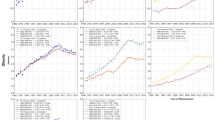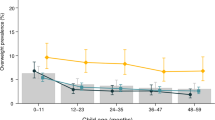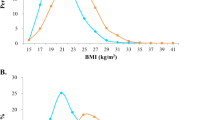Abstract
This analysis examines period trends in body weight of Australian 18–24 year olds. Secondary analysis of National Health Surveys was performed, including examination of socio-demographic determinants of obesity. The prevalence of overweight and obesity has increased from 24.0 and 5.1% in males and 13.2 and 5.8% in females, respectively, in 1995 to 29.3 and 13.8% in males and 20.6 and 20.6% in females in 2012. Mean body mass index (BMI) increased over time from 23.7 (s.d. 3.5) for males and 22.4 (s.d. 4.0) for females in 1995 to 25.2 (s.d. 4.8) and 25.5 (s.d. 5.9) in 2011/2. Lower educational attainment increased the odds of having BMI⩾25.00 kg/m2 for both sexes (P=0.03 males and P<0.001 females). Overweight and obesity were higher in rural females (P<0.05) and those socio-economically disadvantaged (P<0.0001). The obesity epidemic has worsened for Australian young adults and in particular young females.
This is a preview of subscription content, access via your institution
Access options
Subscribe to this journal
Receive 12 print issues and online access
$259.00 per year
only $21.58 per issue
Buy this article
- Purchase on Springer Link
- Instant access to full article PDF
Prices may be subject to local taxes which are calculated during checkout

Similar content being viewed by others
References
Australian Bureau of Statistics (2013). Profiles of Health, Australia, 2011-13: Overweight and Obesity, 2011-2012. Available at: http://www.abs.gov.au/ausstats/abs@.nsf/Lookup/by%20Subject/4338.0~2011-13~Main%20Features~Overweight%20and%20obesity~10007# (accessed on 14 Sept 2014).
Allman-Farinelli M, Chey T, Bauman A, Gill T, James W . Age. period and birth cohort effects on prevalence of overweight and obesity in Australian adults from 1990 to 2000. Eur J Clin Nutr 2008; 62: 898–907.
McTigue KM, Garrett JM, Popkin BM . The natural history of the development of obesity in a cohort of young U.S. adults between 1981 and 1998. Ann Intern Med 2002; 136: 857–864.
Australian Bureau of Statistics National Health Survey 1995: Users’ Guide. ABS: Canberra, 1996.
Australian Bureau of Statistics National Health Survey 2007–2008: User's Guide. ABS: Canberra, 2009.
Australian Bureau of Statistics National Health Survey 2011–2012: Users' Guide. ABS: Canberra, 2013.
Janssen I, Heymsfield SB, Allison DB, Kotler DP, Ross R . Body mass index and waist circumference independently contribute to the prediction of nonabdominal, abdominal subcutaneous, and visceral fat. Am J Clin Nutr. 2002; 75: 683–688.
Olds TS, Tomkinson GR, Ferrar KE, Maher CA . Skeletal muscle mass and distribution in 468 men and women aged 18–88 yr. J Appl Physiol. 2000; 89: 81–88.
Janssen I, Heymsfield SB, Wang Z, Ross R . Skeletal muscle mass and distribution in 468 men and women aged 18–88 yr. Obes Rev 2014; 15: 338–347.
Mamun A, Mannan M . Gestational weight gain in relation to offspring obesity over the life course: a systematic review and bias‐adjusted meta‐analysis. Obes Rev 2014; 15: 338–347.
Acknowledgements
This research received no specific grant from any funding agency in the public, commercial or not-for-profit sectors. AG is currently supported by an Australian Postgraduate award for doctoral studies. MA-F's roles included study design and revision of the manuscript. AG's roles included study design, data analysis and drafting the manuscript.
Author information
Authors and Affiliations
Corresponding author
Ethics declarations
Competing interests
The authors declare no conflict of interest.
Additional information
Supplementary Information accompanies this paper on European Journal of Clinical Nutrition website
Supplementary information
Rights and permissions
About this article
Cite this article
Grech, A., Allman-Farinelli, M. Prevalence and period trends of overweight and obesity in Australian young adults. Eur J Clin Nutr 70, 1083–1085 (2016). https://doi.org/10.1038/ejcn.2016.41
Received:
Revised:
Accepted:
Published:
Issue Date:
DOI: https://doi.org/10.1038/ejcn.2016.41



